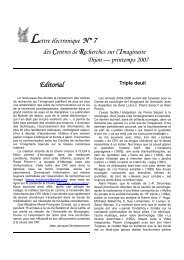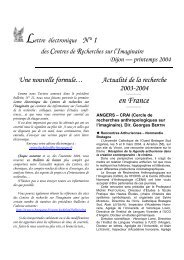AXE 1 - HISTOIRE ET ARCHEOLOGIE - Iulm
AXE 1 - HISTOIRE ET ARCHEOLOGIE - Iulm
AXE 1 - HISTOIRE ET ARCHEOLOGIE - Iulm
You also want an ePaper? Increase the reach of your titles
YUMPU automatically turns print PDFs into web optimized ePapers that Google loves.
Lettres électronique — N° 2 — automne 2004Phantasma, The Centre for Imagination Studiesfrom Babes-Bolyai University in Cluj, the oldest andthe largest University in Romania, has designed aresearch programme on Romanian collective images,stereotypes and prejudices (ROMIMAG), in order toapply for a European Community FP6 grant.ROMIMAG aims to outline the panorama of thecultural perceptions that Romanians hold about themselves,about their neighbours and about Europe. Theimage of the self and the image of the others representcore concepts in defining national and groupidentity, as well as in understanding and assessingresponses to complex political issues, such as theconstruction of the European Community. A successfulEuropean integration relies not only on correcteconomic and political approaches, but also on thegood management of collective representations. An“ecological” study of these shared ideas and imagesshould be able to isolate and expose the commonstereotypes, clichés, covert misconceptions and prejudicesagainst ethnic, gender, sexual and religiousminorities, and against other European nations.Workshop 1. Romanians’ Self-ImagesStarting from Romanticism until the first half of thetwentieth century, ideologists and philosophers havebeen trying to identify what they thought to be theessence or the Platonic quintessence of a people, of anation or of a race. This approach has been thoroughlycriticised, especially after the nationalisticideologies lead to catastrophes such as the Holocaustand the Second World War. In our post-modern era,we know that the idea and the image of a people is aproblem of collective representations. Each group andnation has a specific, sometimes incoherent andpolemical, image of itself. To offer just an example,Romanians hold about themselves two contradictoryimages : that they are a very hospitable, welcomingand generous people, and that they are a chauvinistic,primitive and retractile people. Each of these imagesencloses a very complex constellation of consciousand unconscious reasons and motives that wouldneed a subtle psychoanalysis of the collective mentalities.In order to better understand themselves andmaybe to improve their civic and political behaviour,groups and peoples should bring to light the unspokenmotivations of their self-representations, to dischargetheir potential aggressiveness and violent tendencies.This workshop will target from multiple conjugatedperspectives the images that different social andprofessional groups which form the Romanian societyhave about themselves and about their nation. It willalso investigate the different images that Romanianshave about national minorities (Hungarians, Gypsies,Jews, etc.) and the correspondent images that theseminorities hold about the majority.Workshop 2. Romanians’ Images of the Others 1(Romania and the Balkans)Together with the image of the self, the image ofthe others is an important element in the constructionof the individual and of group identity. This workshopfocuses on the representations that Romanians haveelaborated about their national neighbours from theex-Communist countries of South-Eastern Europe.The Balkans provide a very rich material for the workof historians, sociologists and cultural researchers.Situated at the crossroads of several continentalempires (Rome, Byzantium, Ottoman, Habsburg, Tsaristand Soviet), this geographical space harboured averitable ethnic and cultural melting pot, wheredifferent religions and civilisations hybridised in themost unexpected ways. However, the complexity ofthe Balkans has hardly ever been understood in itsreal and intrinsic implications. For most of the time,both Westerners and local inhabitants have utilisedsimplified and stereotyped formulas with a depreciatoryand misleading effect (“Byzantinism”, “Balkanism”,etc.). A research into the actual psychology ofthese populations through the images they hold abouteach other would help a better understanding of themechanisms of their collective representations. Balkanstudies are not only a theoretical discipline,dealing with humanities and arts, they also constitutea sociological and ideological field of research. Theinvestigation of this domain is especially appropriatein this very fragile and unstable zone of Europe, whichhas remained, as the last fifteen years have unfortunatelyproved it, a neuralgic space of the continent. Itshould also be able to change its perception from ahostile to an open one, emphasising the role of acultural bridge that the Balkans represent betweenEurope and the Orient.Workshop 3. Romanians’ Images of the Others 2(Romania and Central Europe)This third workshop dedicated to imagologystudies complements the two previous ones. After theanalysis of the representations that Romanians holdabout their neighbours from South-Eastern Europe,this approach will tackle the images of Central andWestern Europe. During the past centuries, andespecially during Communism and its “iron curtain”that stifled the free circulation of persons, informationand values, the West exercised a special influenceand fascination on Romanians. The imaginary representationsof the West materialized themselves intoseveral sets of clichés and stereotypes spontaneouslyor ideologically generated, which can be regroupedinto two classes, benevolent and hostile. To give justa sample, one of the recent images of the West relieson the myth of the “conspiracy theory”, issued by”crypto-communists” and by other nostalgics of theprevious regime. In this trend of interpretation, the“capitalist” influence on Romania is satanised. The10 Association Recherche sur l’Image — DIJON















